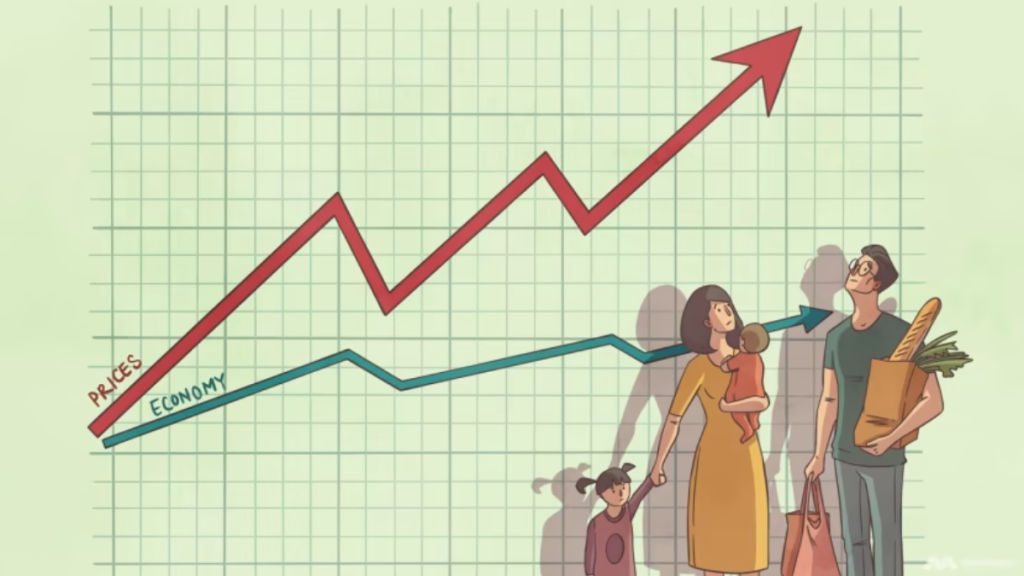WASHINGTON, D.C. — Across the country, Americans are voicing growing frustration as consumer prices continue to rise under former President Donald Trump’s second administration. From grocery store aisles to gas stations, the impact of inflation is being felt by households of all sizes and incomes, sparking renewed concern over the direction of the economy.
With inflationary pressure persisting into the new year, economists are warning that sustained price increases could weaken consumer confidence and complicate federal efforts to stabilize the economy.
Inflation Lingers Despite Promises
When Donald Trump returned to office in January 2025, his administration pledged to “restore economic strength” by lowering taxes, cutting regulations, and increasing domestic energy production. However, recent data from the U.S. Bureau of Labor Statistics reveals that the Consumer Price Index (CPI) has continued to climb—up 4.1% year-over-year as of March—largely driven by housing, food, and energy costs.
While the inflation rate is down from its 2022 peak, many Americans say their wallets haven’t noticed much relief. “Prices might not be rising as fast, but they’re still way too high,” said Maria Rodriguez, a single mother in Phoenix. “I’m spending $80 more a month just on groceries compared to two years ago.”
The Trump administration has blamed continued inflation on past government spending and lingering supply chain issues. In a recent statement, the president said, “We inherited an inflation mess and are working hard to bring costs down, especially for American families.”
Food and Housing Costs Top Concerns
Rising grocery prices remain one of the most visible and frustrating issues for consumers. According to the USDA’s Food Price Outlook, food-at-home prices rose by 3.4% in the last year, with staples like eggs, dairy, and bread seeing the most significant hikes.
Meanwhile, housing continues to be a major pain point. Rent and mortgage rates have climbed steadily as demand continues to outpace supply in many markets. The Federal Housing Finance Agency reports a 6.2% national home price increase year-over-year, adding strain to already tight budgets.
“We’re seeing wage gains in some sectors,” noted Dr. James Ellison, an economist at Georgetown University. “But they’re not keeping pace with inflation in essential categories, especially housing.”

Energy Prices Stir Public Discontent
While global oil markets remain volatile, gas prices in the U.S. have also ticked upward, averaging around $3.75 per gallon nationwide, according to the U.S. Energy Information Administration. This has stirred memories of earlier spikes during Trump’s first term and left many questioning the effectiveness of current energy policies.
The administration has pushed for expanded domestic drilling and fewer environmental regulations as part of its “America First Energy Plan,” but critics argue that such policies take time to influence prices and may carry long-term environmental consequences.
“I voted for Trump to fix the economy, but gas prices are still high, and my energy bill just went up again,” said Charles Bennett, a retiree in Ohio. “When will we actually see the benefits?”
Political Ramifications
With the 2026 midterm elections approaching, rising prices are quickly becoming a key political battleground. While Republicans maintain that the current administration inherited structural economic issues, Democrats argue that Trump’s policies have favored corporate profits over household relief.
Polling data from Gallup shows that 61% of Americans list inflation or the economy as their top concern, a sentiment that spans party lines. Independent voters in particular say they feel squeezed by high costs and uncertain about future economic stability.
“We need real solutions, not just slogans,” said Rep. Linda Wu (D-CA), during a recent congressional hearing. “The American people are tired of watching prices climb while their wages stagnate.”
Federal Response Remains Unclear
The Trump administration has yet to outline a comprehensive inflation reduction strategy. Some officials have hinted at targeted tax relief for middle-class families and price control measures in essential sectors, but no formal proposals have been introduced.
Meanwhile, the Federal Reserve remains cautious. Though interest rates have stayed relatively stable in recent months, Fed Chair Jerome Powell has indicated that further adjustments could be on the table if inflation doesn’t cool more significantly.
“We are closely monitoring the data,” Powell stated in a recent press conference. “Our goal is to achieve price stability while supporting a strong labor market.”
Conclusion
As inflation continues to affect daily life, frustration is mounting across the country. The Trump administration faces increasing pressure to deliver meaningful relief for working families, while economists warn that long-term solutions will require careful, coordinated efforts across both the public and private sectors.
In the meantime, Americans are left to navigate a persistently expensive economy—one that threatens to define the political and financial landscape for years to come.
Disclaimer – Our team has carefully fact-checked this article to make sure it’s accurate and free from any misinformation. We’re dedicated to keeping our content honest and reliable for our readers.
